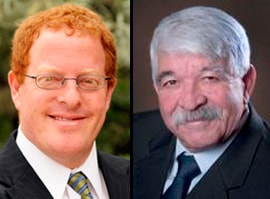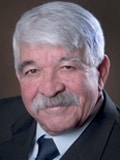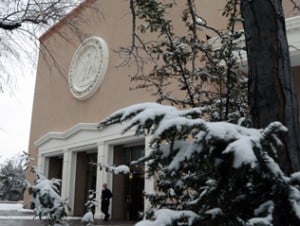
Jeff Steinborn, left, and Antonio Lujan
The difference between Antonio Lujan and Jeff Steinborn, the Democratic candidates for State House District 35, lies in their life experience, personality and political style.
Few primary races this year will offer as much of a contrast as will the Democratic race for State House District 35, whose new boundaries now include much of central and northeast Las Cruces.
Politically and ideologically, incumbent Antonio Lujan and his challenger Jeff Steinborn probably agree on the vast majority of issues, if their legislative records and agendas are any indication.
The difference really does lie in their life experience, personality and political style.
Lujan’s quiet, laid-back demeanor belies a long record as a fierce advocate of social justice. He came of political age in Las Cruces’ Chicano empowerment movements of the early 1970s, and built his grassroots strengths as a director of social ministry for the Catholic Diocese of Las Cruces.
It’s true little of the legislation he’s sponsored has made it through a session (though the same can be said about many others), but he says most of his energy, primarily as a member of the Appropriations and Finance Committee, goes to keeping up on all legislation coming before the House.
The 68-year old great-grandfather ran his first campaign when the 42-year old Steinborn was barely out of diapers, but he really hasn’t faced a stiff challenge for the seat he’s held since 2002.
Conversely, Steinborn has never had an easy time in any of his campaigns, ever since his first run for office in 2004 at the age of 32, when he ran (and lost) in a contested primary for New Mexico’s District 2 seat in the U.S. House.
Another unsuccessful run for the state House followed later in 2004. But once he was elected to the Legislature in 2006, few in Santa Fe could say that Steinborn was not a hard worker who, reportedly on at least one occasion, went against his own party’s leaders during Democratic caucus meetings. He even voted in 2010 against the leadership-crafted budget.
Some have criticized Steinborn as brash, and even arrogant. Steinborn, an unmarried native of Las Cruces, says he’s aware how some see him, but that his “passion” for the issues can lead to him being misunderstood.
He’s not ashamed to admit he wants to hold political office, something he’s focused on since his early 20s as a political science undergraduate at the University of Texas-Austin. But he also says his ambitions lie no further than Santa Fe.
Steinborn also acknowledges that his challenge against a popular incumbent – Lujan has run uncontested in the last two races – has rankled some within the party. But he points out, and Lujan agrees, that with the significant redrawing of the boundaries under the recent redistricting, District 35 has really become a new district. Steinborn says up to 75 percent of it is new area for Lujan.
In the House, Democrats came out of the 2010 “Republican wave,” which saw incumbents like Steinborn losing their seats, with only a three-seat majority, its slimmest since 1953, when Republicans held the majority for one year. The last time Republicans held the majority in the House before that was 1929.
This year, Democratic Party leaders will watch races like the one between Steinborn and Lujan more closely than years before.
The incumbent

“For me my life has been about social justice. It’s been about promoting and supporting the dignity of the human person and looking out for the common good of our communities, for the people who don’t have a voice.” – Antonio Lujan
Lujan moved to Hatch from Marfa, Texas at the age of nine, the fifth of eight children. His parents spoke little English and the family worked a variety of jobs, including running a restaurant in Hatch.
His father Frank, an Army draftee who fought in Europe during World War II, emphasized education and literacy at an early age.
“He was a poet, a deep thinker. He had a fifth-grade education, but he was an avid reader,” Lujan said of his father. “He made the sacrifice to buy us the Britannica (encyclopedia). The reason we moved from Hatch to Las Cruces (in 1960) was to be closer to the university.”
Lujan would become the first in his family to graduate from college; all of his children are college graduates. But he had a hard time “relating” as a student at Las Cruces High School, and would spend hours at the university library reading philosophy, literature and history.
While still a senior, he and a large group of other seniors volunteered for the U.S. Navy. He would end up serving in the early years of the Vietnam War.
Lujan doesn’t mention being a veteran in his campaigns, and is hesitant to talk about his service, other than to say he came out of the service in 1965 opposed to the war.
Funded by the GI Bill and a series of jobs including counselor for the Boys Club of Las Cruces, Lujan earned his bachelors degree in history from New Mexico State University in 1969, at a time when political activism on campus was nearing its peak.
After receiving his master’s degree in social work from Tulane University in New Orleans in 1971, Lujan returned to NMSU as one of the only Hispanic members of the faculty.
“If it weren’t for affirmative action, I wouldn’t have had the opportunities I had,” Lujan said.
Yet change came slow, and Lujan helped organize the Alianza Universidad, which advocated for more Hispanic faculty, and the first Chicano Programs. He also protested alleged brutality by Las Cruces police.
“When I was still teaching, the class was ‘Social Issues in Action,’ and one of my students ran for city commission. The class became the (campaign) committee. That really sparked an interest for me,” Lujan said.
First race
In 1975, the father of three ran unsuccessfully for the Las Cruces School Board against popular incumbent Mary Salopek:
“I was just dissatisfied with the school system. I was very angry. I don’t know how fair I was (in my criticism). In retrospect, I was confusing policy and programming, that the school board somehow had the ability to enact the change I wanted to see.”
Lujan lost the urge to run for office, but got involved with the Democratic Party and running campaigns. He also worked with the Social Ministries for the Diocese, focusing on improving conditions within the colonias “before it was fashionable.”
His interest in political office changed around 2001, when the ailing District 35 state representative Benjamin Rios, an old friend and political ally who lived just down the block from Lujan in the Mesquite Historic District, urged him to run.
“(Former representative) J. Paul Taylor also talked to me about running. He knew about my reputation as an organizer. He said he’d held out for a long time for someone who cares for the poor,” Lujan said.
That was his first campaign, for which he raised $24,000. Much of it, according to campaign finance records, came from party insiders, industry and trade lobbyists, and his political friends.
At the time, District 35 was still primarily an inner city district, heavily Democratic and Hispanic. For a community organizer with fluent ease with Spanish, he prevailed easily over his Republican challenger, as he did against Republican Lawrence Joy in 2004 and 2006.
He’s run unopposed since.
‘Common good’
As a legislator, Lujan points to directing millions of state dollars into the ongoing revitalization of downtown Las Cruces, including some of the first beautification projects for the Mesquite Historic District. He also sponsored legislation expanding rights and protection to day laborers.
He hopes to try again in his attempt to get his bill through that would ban texting while driving, which has been killed in committee the last two years.
Lujan wasn’t happy with the governor’s redrawn District 35 boundaries. The district now includes almost 30,000 voters in a disparate area ranging from the oldest Las Cruces barrio to the semi-rural areas off Doña Ana Road and the still-developing East Mesa neighborhoods north of Elks Drive.
After the new district was determined, Lujan got a call from Steinborn.
“He said he’d heard I was going to retire. I said I didn’t know where he got that, but that no district belongs to anybody, and that he should go ahead and run. The one thing I asked him in a demonstration of leadership was that we run positive campaigns, and as far as I can tell, that’s what he’s done. I don’t have any animosity towards him at all. It is his right.”
Lujan says he’s come to live his life according to Don Miguel Ruiz’s “The Four Agreements,” a sort of self-help guide that emphasizes, in part, modesty, integrity, sincerity and not taking anything personally.
“I really don’t enjoy the publicity. I’m not being falsely modest. On the floor (of the Legislature) or in committee, when I speak, it is because something that hasn’t been said needs to be said. There are a lot of people who talk, who repeat things, because they like to hear themselves,” Lujan said.
“For me my life has been about social justice. It’s been about promoting and supporting the dignity of the human person and looking out for the common good of our communities, for the people who don’t have a voice. That’s what’s kept me from giving up,” he said.
The comeback kid
“I’m not one of those guys who sits in his chair and, frankly, doesn’t work very hard. … I can actually show I’ve done the things I promised I would do, or at least tried to do. The more people get to know me, the more they know what’s in my heart.” – Jeff Steinborn
In April 1970, Steinborn and his identical twin brother Dan became some of the last people born at Memorial General Hospital at the corner of Alameda Boulevard and Amador Avenue.
He grew up here, attending Las Cruces’ public schools, and spent much of his youth oblivious to the shadow that would follow him for much of his early political career.
His father was David Steinborn, credited and extolled, as well as criticized and even reviled by some, for his role in the growth of Las Cruces towards the east.
The older Steinborn was a prominent and successful developer and later served as city mayor of a city commission that approved a controversial annexation of thousands of acres on the East Mesa.
For years, some of the first questions Steinborn would answer were about his father.
“There’s no question. Obviously Steinborn was a well-known name when I first ran for office. The only association people had was my father,” Steinborn said.
But as a kid, his dad’s public service really didn’t spark much of an interest in politics.
“Later on, when I learned more about public policy and how things get done, I definitely learned to appreciate the things he did as mayor,” Steinborn said. “A lot of people give him credit for making Las Cruces what it is. The city is still growing into the shoes he made. We’re extremely close; we talk all the time. He’s been on the receiving end of criticism, and he knows what that’s like. ”
As the teenage son of recently divorced parents, Steinborn said he had other things on his mind, like playing drums.
“As a 13-year old kid, I wasn’t into politics. I was just struggling to make it in junior high. I was honored and proud of him. But yes, kids would sometimes tease you about it,” Steinborn said.
He ended up following his older brother Alan’s footsteps at the New Mexico Military Institute, where he’d eventually graduate in 1988.
“There is no culture shock like having a 15-year old, head shaved, standing at attention, marching and being yelled at, losing all your freedom a 15-year old is used to. It was pretty extreme at times,” Steinborn said.
Steinborn said he got used to the rigor, and soon his unit was choosing him to represent them in competitions.
Political drummer
The political switch got turned on watching the 1988 presidential campaign of Dukakis-Bush.
“I was just fascinated,” Steinborn said.
He considered going into the Army after graduation, and even took the entrance exam, but severe allergies led to the Army delaying his enlistment. He opted instead to enter college – he was accepted into the Army after he’d already left for school – at the University of Texas in Austin, where his mother and identical twin brother Dan lived.
There he not only immersed himself in college life and political science studies, but he also pursued his other passion: music. He played drums with his bass-playing brother in a rock-n-roll band called Urban Roots, playing parties and clubs around Austin.
At one of their shows, Joe King Carrasco, a Tex-Mex rock-n-roll legend of sorts, approached the band about playing some shows with him. Steinborn maintained a friendship with Joe King, even backing him up on percussion at a show at El patio several years ago.
Steinborn still plays, most recently with his group the Rhythm City Dogs.
“I think some people would be surprised I can actually deliver a pretty good cumbia,” Steinborn said.
But it was always politics where Steinborn wanted to be. After graduation, he landed a job in 1995 as a congressional aide to then-U.S. Congressman Bill Richardson.
Between 2001 and 2003, Steinborn worked as an aide to Sen. Jeff Bingaman, primarily serving as a field representative in southern New Mexico.
He also co-founded several policy oriented action groups, including the High Tech Consortium, the Southwest New Mexico Border Task Force, and CURBside Recycling, which helped successfully lobby for the implementation of curbside recycling in Las Cruces.
State ambition
Since 2005, Steinborn has worked for the New Mexico Wilderness Alliance, and is now its current Southern New Mexico director. Most recently in that role, Steinborn has helped lead the effort to secure national monument protection for the Organ Mountains and at least some of the surrounding areas.
All of these reflect Steinborn’s interest in policy, which he says is his primary motivation in seeking office.
He got some flak for his precociousness for his primary run for Congress in 2004. He said he did have some experience in Washington and in working the district, but that the Democratic leadership backed Gary King, and probably didn’t want Steinborn in the primary to begin with.
“I had a burning passion for that office. Wild horses couldn’t have kept me from that race. I felt then as I feel now (District 2 U.S. Rep.) Steve Pearce’s policies are wrong for this country,” Steinborn said. “I was being true to who I was. It was something I needed to do.”
It did force him to focus more at the state level, where policy affected New Mexico. After another failed run at state office later in 2004, Steinborn finally won the open state House seat in 2006. He retained his seat in 2008.
“I don’t view state office as a stepping stone at all. I’m going to give this job my all. It’s going to take all my time and energy. I’m really not someone who needs the limelight and the accolades,” Steinborn said.
But he’s not shy about telling people what he’s done, or wants to do, in office:
“I definitely learned the only way constituents will know what you have done is if you tell them. I’m not one of those guys who sits in his chair and, frankly, doesn’t work very hard. It does sound like you’re being self-promotional sometimes. Sometimes I do cringe when I do it, but people are sick of politicians promising things. I can actually show I’ve done the things I promised I would do, or at least tried to do. The more people get to know me, the more they know what’s in my heart.”
In his campaign literature, Steinborn offers a list of accomplishments, including securing funding for the city’s downtown revitalization project, jobs training, expanded hospice services, and even for the planning of a state veterans museum in Las Cruces. He supported legislation to reduce taxes on veterans, limit campaign contributions in state elections, and reforms of the state land office.
In 2010, Steinborn lost his seat to Terry McMillian, who he said not only waged a good campaign but also benefitted from the political pendulum swing to the right.
“It was a wave election, by and large. Voters were frustrated with Washington and wanted to send a message,” Steinborn said.
Steinborn said “one or two people” have said they were a little upset he chose to run against Lujan. He knows Lujan will have the endorsements of some of the groups who backed him in the past.
But he said the new District 35 includes 38 percent of his old district. And besides, he wants the job.
“This is not about Antonio. I have great respect for him. It’s about my record of achievement. I knew getting into this he would have most of the endorsements. I know that’s not personal. I’m a person of substance, and a pretty hard worker. People can get caught up in style. Judge me for what I have done and what I want to do.”

The Roundhouse in Santa Fe (Photo by Heath Haussamen)
The campaign picture
Lujan and Steinborn agree District 35 is really a new district.
It now includes almost 30,000 people, and encompasses within its jigsaw, seemingly arbitrary borders much of the downtown area north to Engler Road off Valley Drive and to the northeast up the East Mesa to Rinconada Boulevard.
Steinborn says up to 75 percent of it is new to Lujan, while 38 percent of it used to lie in his district.
Both will have to do a lot of introducing themselves over the next few weeks, and since there are no forums or major events planned, that’s going to mean lots of mailers and going door-to-door, one street and neighborhood at a time.
Against Steinborn, Lujan will probably have to raise more money than he ever has before. He has raised a total of $69,885 since his first race in 2002; Steinborn has raised seven times than that.
Lujan’s going against someone who has shown an ability to raise large sums, although in the past a good chunk of that has come from the Democratic Party or top leaders, neither of which are likely to play a role in this primary.
The 2012 Democratic primary may end up being the toughest campaign Lujan has yet had to undertake.
He’s run totally unopposed in the last two elections. His last challenge came in 2006 against Joy, who he also resoundingly beat in 2004. Joy did not get the full political backing of the Republican Party, and Lujan not only totally outraised him, he also prevailed by a 3-to1 vote margin.
Lujan won his first race in 2002, winning longtime legislator Benjamin Rios’ backing and his open seat. In his first election, Lujan beat Republican Henry Young resoundingly and outraised him $24,000 to $590.
According to FollowTheMoney.org, in the past Lujan’s top contributors have included various lobbyists, including the New Mexico Trial Lawyers Association, as well as trade and industry unions, party committees and fellow candidates.
In comparison, Steinborn’s victories have come after highly competitive and sometimes-contentious campaigns. He seems nonplused about taking on formidable challenges.
He first ran for District 37 in 2004 against incumbent Republican William “Ed” Boykin. He outraised Boykin but lost the race.
Boykin opted to not run for reelection in 2006. According to FollowTheMoney.org, Steinborn raised $113,097 that year, and in one of the closest and most expensive legislative campaigns, narrowly beat Republican Scott Witt by just more than 300 votes.
In the 2008 general, Steinborn beat former Doña Ana County Commissioner W. Kent Evans, buoyed by a $201,107 campaign chest, half of which came from the party and other House Dems (with more than $15,000 derived from lobbyists or industry group lawyers).
Steinborn lost his seat by fewer than 400 votes in 2010 to Republican McMillan, a Las Cruces physician who took 51 percent of the vote to Steinborn’s 48.
Obviously, this June it will come down to who can motivate their supporters to actually show up at the polls. Whoever wins will face Republican political newcomer Charles D. Green in the general.
Christopher Schurtz is a freelance writer and historian in Las Cruces. He has covered Las Cruces and New Mexico politics since 1999.
